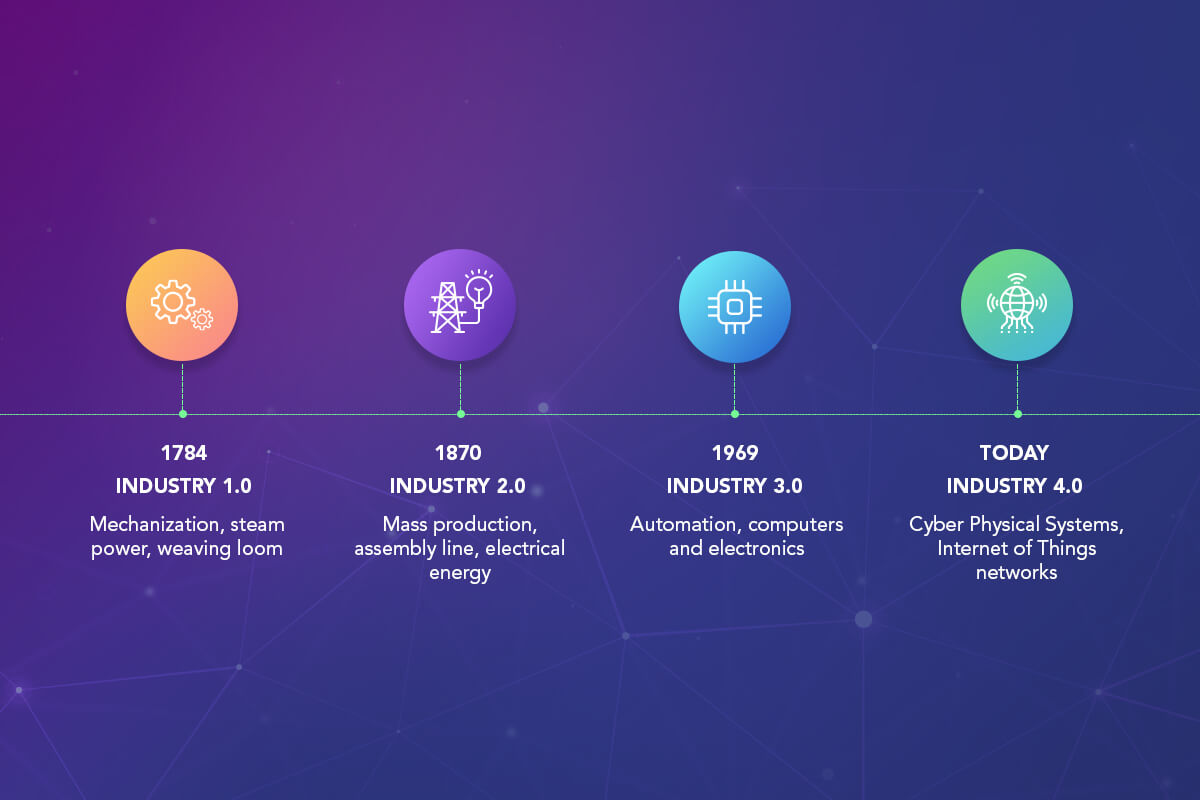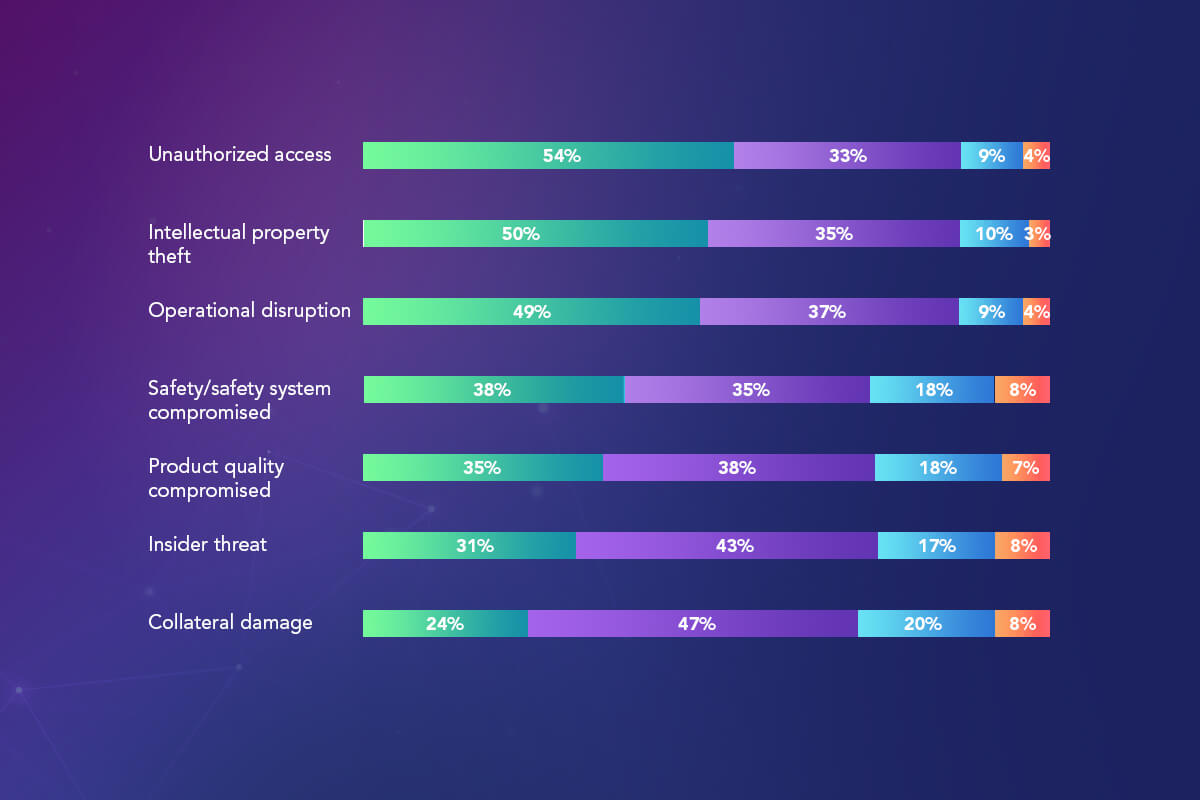Softengi has developed a proprietary driver set for embedded device data interchange on the internet for the client who chose to be undisclosed. It advances the proven and trusted secure communication methods one step further. The driver set has enabled better reliability and attack-resistance, as well as manageability for a cyber-physical system. Having accumulated this unique experience of development, we would like to share our ideas on the challenges and solutions in the IoT for manufacturing and logistics.
IoT for Manufacturing: Embedded Devices Connectivity
The manufacturing process starts from supply in many cases. The supply chains are evolving under the pressure of COVID, and more and more businesses rely on domestic providers, according to HBR. Factory automation comes to the forefront, given the lack of locally available specialized labor. Apart from aspirations, the automated manufacturing method must come cheaply. Otherwise, in a highly competitive market, cheap labor wins against any automation, be it at the cost of lower product quality.
Therefore, the actual trend for automation is supposed to enable inexpensive and, at the same time, high-quality goods manufacturing. The low costs are a new factor distinguishing the current from the previous push for automation.
That is how COVID made manufacturing 4.0 closer.

The cyber-physical manufacturing systems, which provide high quality, can produce small product batches. The latter are approaching individual customization in size. That means that the same assembly line would need to refocus on the production of various products during its lifetime. Formerly such a refocus would require assembly line redesign and some hardware changes.
In contrast, the ability to change output programmatically without any hardware change is the new requirement. The Internet of Things (IoT) is an engineering approach that might enable code-driven manufacturing.
That is why IoT has become an integral part of smart supply chains and smart manufacturing, especially after COVID-19.
A set of physical assets is interlinked via the internet huddle to produce a batch. Depending on the product, different sets of assets join their efforts. Given that an IoT-enabled cyber-physical system would be more capable and complex, it would be more expensive. It puts an overhead on the product costs.
This constitutes the major problem to solve for manufacturing, one of 5 major challenges defined by PwC.

Digging deeper reveals that a manufacturing system has two cost components: capital expenditures (CAPEX) and operational expenditures (OPEX). High CAPEX, which is driven by equipment investments, might be acceptable for some high-margin goods, particularly in our case, for long-lived equipment. It is not an issue.
High OPEX is the most prohibitive factor for more automation (see figure, optimal system complexity). The more complex automated manufacturing will be enabled by larger IoT fleets. Larger fleets are enabled by:
- Extending nomenclature of IoT devices;
- Lowering the costs of integrating them into a system.
The latter is the addressed problem. It has two administrative aspects: device configuration effort and system maintenance effort. The cornerstone for the former is human-machine interface automation, for the latter is cybersecurity.
To resolve the seemingly contradictory requirement of low system costs while providing potential for high quality and variable output, the technology has to enable low administrative costs. It would shift economically viable system size towards a system with larger member numbers. The larger system size would enable a more complex and adjustable system.
Challenges in IoT Manufacturing Development: Better Cybersecurity for IoT & Cost-Effectiveness
As stated above, there were two tasks for us. One task has been mandated by the client (better IoT cybersecurity). The other was a latent issue (device configuration/cost-efficient administration). Solving one without the other wouldn’t produce a competitive technology. Since the client intended to enable complex IoT system deployment in an industrial setting, the initial challenge was to produce a product while being mandated to develop a feature.
We’ve already created an article dedicated to IoT security, covering the layers where security breaches can occur and possible precaution measures.
The mandated task was to address an issue of reliability for an IoT-enabled manufacturing system. Embedded devices on the internet must work in accord to become a meaningful system. The coordinated operation is easily disturbed by adversaries. Devices have to communicate reliably despite attempts to intervene.
Here are the most common OT security problems in manufacturing, according to Deloitte, that are connected to IoT and all the Industry 4.0 implementations.

Preserving the Advanced Level of IoT Security for Manufacturing Systems
Contemporary secure communication depends on either shared key or public key infrastructure. The former is cumbersome to administer for large IoT fleets (multi-key), or it would be attack-prone (single-key). Gaining access to the internals of one IoT device exposes the single key for many network nodes. The latter produces a single point-of-failure system. The former system becomes inoperational due to segmentation.
The late OPC-UA (Open Platform Communications United Architecture) approach introduces PKI (Public Key Delegation) onto dedicated servers within IoT segments. It solves the issue of segmentation. Unfortunately, it increases administrative workload, increases BOM’s bottom line, and expands the attack surface for the single point of failure. Massive industrial IoT deployments with OPC-UA wouldn’t gain a technological edge. That is, there will be no economically viable breakthrough in IoT fleet scale to expect. So the challenge was to go beyond the known, which is still not solved.
The adoption challenge accompanied the creativity challenge. The industry had split into OT and IT domains. Solving the task in the OT domain by advancing IT tricks doesn’t help to produce welcomed technology. It required adding another UI layer to hide most of the complexities. Fortunately, it aligned with the need to provide convenient device administration so that solution converged.
The Softengi team has helped the customer to:
- A better understanding of the issue at hand and its limitations;
- Draw an appropriate project charter;
- Reduce CAPEX by saving on technology development;
- Reduce OPEX by picking proper technology architecture;
- Deepen the know-how by designing an improved distributed PKI algorithm;
- Develop the driver set for embedded device interlinkage. It consisted of:
- Embedded driver library;
- Distributed PKI server;
- Network administration application.
- Port the drivers onto several hardware platforms;
- Trained personnel to tune in for low OPEX.
Results and benefits:
- Has become exclusive owner of a leading-edge technology and know-how;
- Obtained POC and MVC code bases;
- Has been able to hit all targets on costs and quality;
- Went on with prepared personnel to the next business step;
- Receive support on demand.
A driver set for communication among embedded devices has been developed from scratch. The infrastructure components have been appropriately integrated. The code has been packaged into a competitive product.
A product consisting of:
- Communication drivers for a list of embedded platforms;
- Distributed PKI infrastructure components;
- Application to administer IoT system.
The solution has been developed from scratch to satisfy contradictory requirements. It can advance flexibility and robustness in industrial cyber-physical manufacturing systems. The systems built upon the technology will enable the establishment of commercially viable local factories. The unique features are advanced IoT security and lower costs of the IoT fleet administration.
Transforming Huge Computer Systems into Cyber-Physical Systems with Minimal Losses
The Internet of Things is a relatively new technological phenomenon. It is the last offspring on the evolutionary path: mainframe computer – cluster computer – on-premise server – edge computer – IoT device.
Most people adore new toys, so ideas on how to reap benefits from IoT pop up regularly. The ideas work well for the ever-diminishing scale of a problem at hand. That is, computing capacity reduction at a computing node plays along if the task complexity is low and computing miniaturization advances.
Some tasks can be helped by lighting up e-matches instead of bare wood! The majority can’t. The true power of IoT systems lies in the capability to simultaneously:
- Attach a digital companion to any item in sight on a diminishing scale;
- Align actions performed by a swarm of interrelated IoT nodes.
Manufacturing and logistics systems have been long equipped with ICT systems of previous generations, i.e., large computing nodes. As a result, the majority of them have scalability and robustness issues. Here are a couple of issues that manufacturing and logistics companies usually face ( and those that can be solved with the help of IoT).
1. Cargo tracking or asset tracking. Today a cargo container can easily be monitored remotely. Nevertheless, some cargo is still open and some goods are stolen. Placing a tracker in a box (multiple boxes in a container) could make it easier to prevent and investigate any incident. It requires cost reduction for trackers and handling two orders of magnitude larger numbers of assets. It is a task for IoT.

2. IoT for the Assembly Line. Assembly lines are generally inflexible. Product customization is available mostly in product attributes – not in product variety. Reconfiguring an assembly line for a different product line may take hours to months. Having assembly line components gather together for a task and then split apart on demand would produce a flexible production system fit to high consumer demands. It is a task for IoT.
Firstly, big computers act as central control hubs. The hubs serve responses to all requests originating in the periphery. The larger the system scale is – the more intensive these requests are. A proportionally raised requests rate requires a multiple of that in spending on big iron. That naturally limits the size of commercial systems.
Secondly, acting as a hub requires long connections to the periphery. The larger the system scale is – the further requests and responses are traveling. It introduces significant lag to control loop commands and increases the blackout area, i.e., periphery segments that are temporarily incapable of communicating with the center.
Delegation of decision-making to periphery nodes could significantly reduce costs and improve the robustness of the system.
Conclusion
The aforementioned principles can work in reverse. A much larger scale and coverage system could be implemented for the same money while the overall reliability improves. This seemingly tempting opportunity brings several challenges. For example, node administration costs are rising, and the level of security is decreasing. It is challenging for a novice to design a proper system, even at the edge computing level. A large share of contemporary IoT systems is unprepared for serious businesses. Outsourcing clients largely see the benefits of their system design and then arrive cold at prospects.
Having accumulated this unique experience, we can truly say that the IoT systems developed by Softengi are working and performing.





